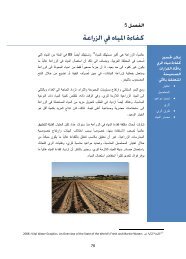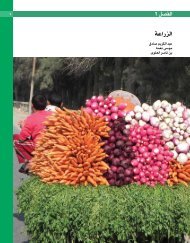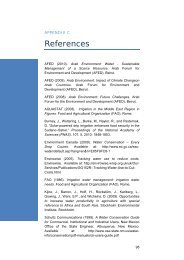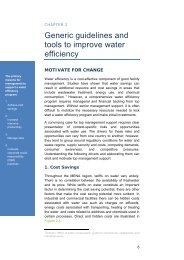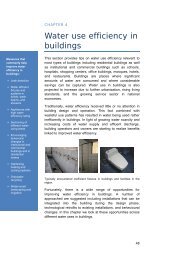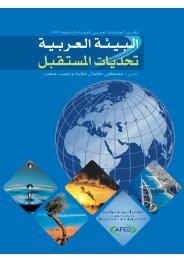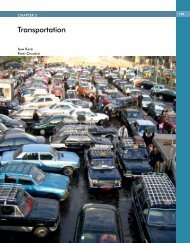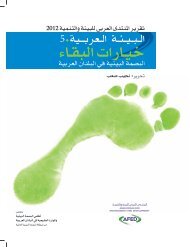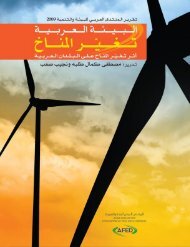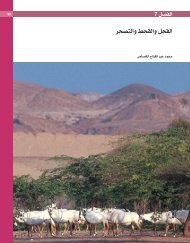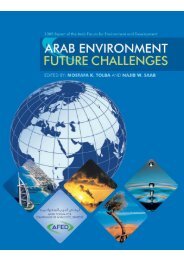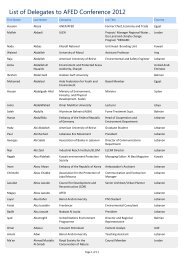Impact of Climate Change on Arab Countries - (IPCC) - Working ...
Impact of Climate Change on Arab Countries - (IPCC) - Working ...
Impact of Climate Change on Arab Countries - (IPCC) - Working ...
You also want an ePaper? Increase the reach of your titles
YUMPU automatically turns print PDFs into web optimized ePapers that Google loves.
ARAB ENVIRONMENT: CLIMATE CHANGE 103<br />
additi<strong>on</strong>, dolphins and whales in internati<strong>on</strong>al<br />
waters were classified in 2000 as critically endangered,<br />
endangered or vulnerable and numbered<br />
between 11-16 species <strong>on</strong> the northern coast <str<strong>on</strong>g>of</str<strong>on</strong>g><br />
Morocco and between 6-10 species in the<br />
Mediterranean Basin, the coast <str<strong>on</strong>g>of</str<strong>on</strong>g> Mauritania,<br />
and the southern coast <str<strong>on</strong>g>of</str<strong>on</strong>g> Morocco (The Atlas <str<strong>on</strong>g>of</str<strong>on</strong>g><br />
Endangered Species, 2005).<br />
With the inevitable global phenomen<strong>on</strong> <str<strong>on</strong>g>of</str<strong>on</strong>g> climate<br />
change, freshwater biodiversity in the <strong>Arab</strong><br />
world will be greatly impacted and many <str<strong>on</strong>g>of</str<strong>on</strong>g> these<br />
precious resources will not survive. Table 4b outlines<br />
the <strong>Arab</strong> countries with excepti<strong>on</strong>al large<br />
areas designated as wetlands <str<strong>on</strong>g>of</str<strong>on</strong>g> internati<strong>on</strong>al<br />
importance in accordance to the Ramsar<br />
C<strong>on</strong>venti<strong>on</strong>.<br />
Ornithological diversity c<strong>on</strong>stitutes a major asset<br />
to the <strong>Arab</strong> world as well as a high risk area in<br />
terms <str<strong>on</strong>g>of</str<strong>on</strong>g> climate change impacts. Many <strong>Arab</strong><br />
countries lie <strong>on</strong> important bird migrati<strong>on</strong> routes.<br />
Djibouti, which is a crossroad in the transc<strong>on</strong>tinental<br />
North-South migrati<strong>on</strong> corridor, accommodates<br />
1 milli<strong>on</strong> birds per year. Mauritania is<br />
home to the biggest wader populati<strong>on</strong> in the<br />
world and milli<strong>on</strong>s <str<strong>on</strong>g>of</str<strong>on</strong>g> migratory birds come to<br />
the country to stay through the winter m<strong>on</strong>ths,<br />
while the Hawar Islands <str<strong>on</strong>g>of</str<strong>on</strong>g> Bahrain house the<br />
largest breeding col<strong>on</strong>y <str<strong>on</strong>g>of</str<strong>on</strong>g> Socotra cormorant in<br />
the world. There are many threatened Marine<br />
Important Bird Areas in the Middle East including<br />
the eastern side <str<strong>on</strong>g>of</str<strong>on</strong>g> the Red Sea al<strong>on</strong>g the<br />
coastline <str<strong>on</strong>g>of</str<strong>on</strong>g> Saudi <strong>Arab</strong>ia, both Eastern and<br />
Western coastlines <str<strong>on</strong>g>of</str<strong>on</strong>g> the Persian Gulf, al<strong>on</strong>g the<br />
coastline <str<strong>on</strong>g>of</str<strong>on</strong>g> the Gulf <str<strong>on</strong>g>of</str<strong>on</strong>g> Oman and <strong>Arab</strong>ian Sea,<br />
al<strong>on</strong>g the Mediterranean coastline <str<strong>on</strong>g>of</str<strong>on</strong>g> Leban<strong>on</strong><br />
and Palestine, and within the Gulf <str<strong>on</strong>g>of</str<strong>on</strong>g> Aqaba. The<br />
number <str<strong>on</strong>g>of</str<strong>on</strong>g> threatened birds classified as critically<br />
endangered, endangered or vulnerable in 2004<br />
ranged between 11 and 30 species in all <strong>Arab</strong><br />
countries except for Leban<strong>on</strong>, Libya, Qatar,<br />
Sudan, and Tunisia which have between 6 to 10<br />
species recorded as threatened (The Atlas <str<strong>on</strong>g>of</str<strong>on</strong>g><br />
Endangered Species, 2005). The number <str<strong>on</strong>g>of</str<strong>on</strong>g><br />
threatened birds <str<strong>on</strong>g>of</str<strong>on</strong>g> prey classified as critically<br />
endangered, endangered or vulnerable in 2000<br />
ranged between 5 and 6 species in Saudi <strong>Arab</strong>ia,<br />
3 to 4 species in Egypt, Morocco, Sudan,<br />
Djibouti, Jordan, Palestine, Syria Leban<strong>on</strong>, Iraq,<br />
UAE, Kuwait, and Yemen, and in the remaining<br />
countries between 1 and 2 species (The Atlas <str<strong>on</strong>g>of</str<strong>on</strong>g><br />
Endangered Species, 2005). In terms <str<strong>on</strong>g>of</str<strong>on</strong>g> the<br />
TABLE 1<br />
SPECIES NUMBERS ACROSS THE ARAB WORLD<br />
Country Plants Animals<br />
Algeria 3,164(a) 2,941 (b)<br />
Bahrain 195 (b) -<br />
Djibouti 826 (b) 1,417 (b)<br />
Egypt 2,076 (a) -<br />
Iraq - -<br />
Jordan 2,100 (a) -<br />
Kuwait 234 (a) -<br />
Leban<strong>on</strong> 3,000 (a) 4,486 (b)<br />
Libya 1,825 (a) -<br />
Mauritania 1,100 (a) 1,417 (b)<br />
Morocco 3,675 (a) -<br />
Oman 1,204 (a) -<br />
Palestine - -<br />
Qatar 371 (b) -<br />
Saudi <strong>Arab</strong>ia 2,028 (a) -<br />
Somalia 3,028 (a) -<br />
Sudan 3,137 (a) -<br />
Syria 3,000 (a) 2,518 (b)<br />
Tunisia 2,196 (a) 2,244 (b)<br />
United <strong>Arab</strong> Emirates - -<br />
Sources: a) United Nati<strong>on</strong>s Envir<strong>on</strong>ment Programme, 2005 (a) ; b) CBD nati<strong>on</strong>al reports<br />
TABLE 2<br />
Abbreviati<strong>on</strong><br />
CR<br />
EN<br />
VU<br />
IUCN THREAT<br />
CATEGORIES (2008)<br />
Category<br />
Critically endangered<br />
Endangered<br />
Vulnerable<br />
number <str<strong>on</strong>g>of</str<strong>on</strong>g> threatened seabirds classified as critically<br />
endangered, endangered or vulnerable in<br />
2000 most countries either did not have any data<br />
or reported 0 species except for Iraq, Kuwait,<br />
Bahrain, Saudi <strong>Arab</strong>ia, Qatar, the UAE, Oman,<br />
and Yemen which reported between 1 and 2<br />
species (The Atlas <str<strong>on</strong>g>of</str<strong>on</strong>g> Endangered Species, 2005).<br />
II. AGRO-BIODIVERSITY AND SMALL<br />
ARAB COMMUNITIES<br />
The <strong>Arab</strong> world is home to several Centres <str<strong>on</strong>g>of</str<strong>on</strong>g><br />
Origin (aka Vavilov Centers <str<strong>on</strong>g>of</str<strong>on</strong>g> Diversity) which<br />
are geographical areas where a group <str<strong>on</strong>g>of</str<strong>on</strong>g> organisms,<br />
either domesticated or wild, first developed<br />
their distinctive properties. Until today Vavilov<br />
centres are regi<strong>on</strong>s where a high diversity <str<strong>on</strong>g>of</str<strong>on</strong>g> wild<br />
relatives to various crops can be found, representing<br />
the natural relatives <str<strong>on</strong>g>of</str<strong>on</strong>g> domesticated crop



